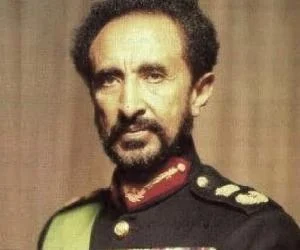File:Haile-selassie-ethiopian king.webp
Haile-selassie-ethiopian_king.webp (300 × 250 pixels, file size: 11 KB, MIME type: image/webp)
| This is a file from the Wikimedia Commons. Information from its description page there is shown below. Commons is a freely licensed media file repository. You can help. |
Summary
| DescriptionHaile-selassie-ethiopian king.webp |
English: Haile Selassie I (Ge'ez: ቀዳማዊ ኀይለ ሥላሴ, romanized: Qädamawi Häylä Səllasé,[nb 2] Amharic pronunciation: [ˈhaɪlə sɨlˈlase] (listen);[nb 3] born Tafari Makonnen; 23 July 1892 – 27 August 1975)[4] was Emperor of Ethiopia from 1930 to 1974. He rose to power as Regent Plenipotentiary of Ethiopia (Enderase) for Empress Zewditu from 1916. Haile Selassie is widely considered a defining figure in modern Ethiopian history, and the key figure of Rastafari, a religious movement in Jamaica which emerged shortly after he became emperor in the 1930s.[5][6] He was a member of the Solomonic dynasty which claims to trace lineage to Emperor Menelik I, believed to be the son of King Solomon and Makeda the Queen of Sheba.
Haile Selassie attempted to modernize the country through a series of political and social reforms, including the introduction of the 1931 constitution, its first written constitution, and the abolition of slavery. He led the failed efforts to defend Ethiopia during the Second Italo-Ethiopian War and spent most of the period of Italian occupation exiled in England. In 1940, he traveled to Sudan in order to assist in coordinating the anti-fascist struggle in Ethiopia, and returned to his home country in 1941 after the East African campaign. He dissolved the Federation of Ethiopia and Eritrea, which was established by the UN General Assembly in 1950, and annexed Eritrea into Ethiopia as one of its provinces, while fighting to prevent secession.[7] Haile Selassie's internationalist views led to Ethiopia becoming a charter member of the United Nations.[8] In 1963, he presided over the formation of the Organisation of African Unity, the precursor of the African Union, and served as its first chairman. In 1974, he was overthrown in a military coup by a Marxist–Leninist junta, the Derg. Haile Selassie was assassinated on 27 August 1975.[9][10] Among some members of the Rastafari movement, Haile Selassie is referred to as the returned messiah of the Bible, God incarnate. This distinction notwithstanding, he was a Christian and adhered to the tenets and liturgy of the Ethiopian Orthodox Church.[11][12] The Rastafari movement was founded in Jamaica sometime around 1930 and its followers are estimated at between 700,000 and one million as of 2012.[13] He has been criticized by some historians for his suppression of rebellions among the landed aristocracy (the mesafint), which consistently opposed his reforms; some critics have also criticized Ethiopia's failure to modernize rapidly enough.[14][15] During his rule the Harari people were persecuted and many left the Harari Region.[16] His regime was also criticized by human rights groups, such as Human Rights Watch, as autocratic and illiberal.[15][17] Although some sources state that late during his regime the Oromo language was banned from education, public speaking and use in administration[18][19][20] there was never an official law or government policy that criminalized any language.[21][22][23] The Haile Selassie government relocated numerous Amharas into southern Ethiopia where they served in government administration, courts, and church.[24][25][26] Following the death of Hachalu Hundessa in June 2020, the Statue of Haile Selassie in Cannizaro Park, London was destroyed by Oromo protesters, and his father's equestrian monument in Harar was removed |
| Date | |
| Source | Own work |
| Author | Iimp |
Licensing
- You are free:
- to share – to copy, distribute and transmit the work
- to remix – to adapt the work
- Under the following conditions:
- attribution – You must give appropriate credit, provide a link to the license, and indicate if changes were made. You may do so in any reasonable manner, but not in any way that suggests the licensor endorses you or your use.
- share alike – If you remix, transform, or build upon the material, you must distribute your contributions under the same or compatible license as the original.
Captions
Items portrayed in this file
depicts
2 September 2022
File history
Click on a date/time to view the file as it appeared at that time.
| Date/Time | Thumbnail | Dimensions | User | Comment | |
|---|---|---|---|---|---|
| current | 05:14, 3 September 2022 |  | 300 × 250 (11 KB) | Iimp | Uploaded own work with UploadWizard |

